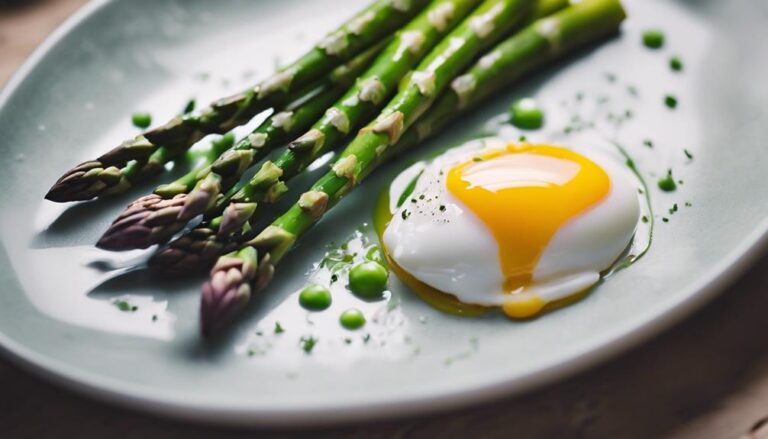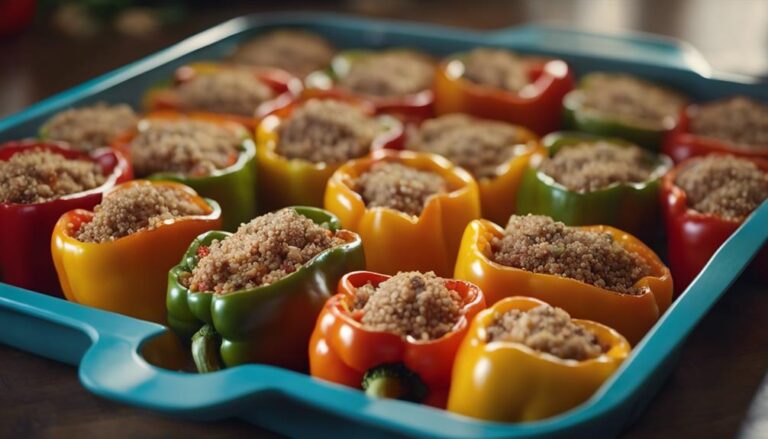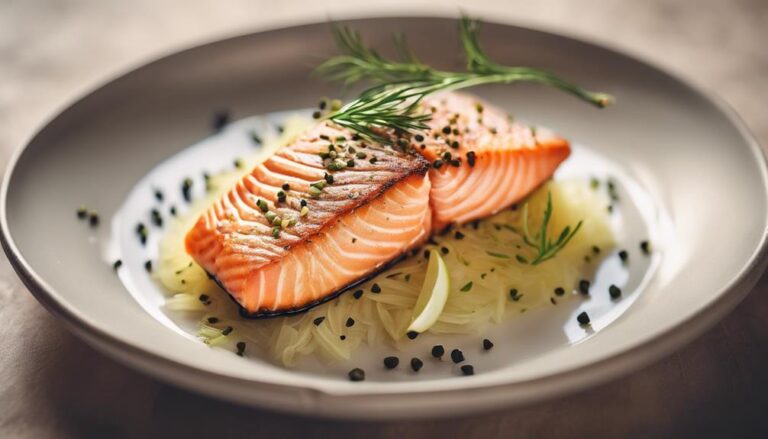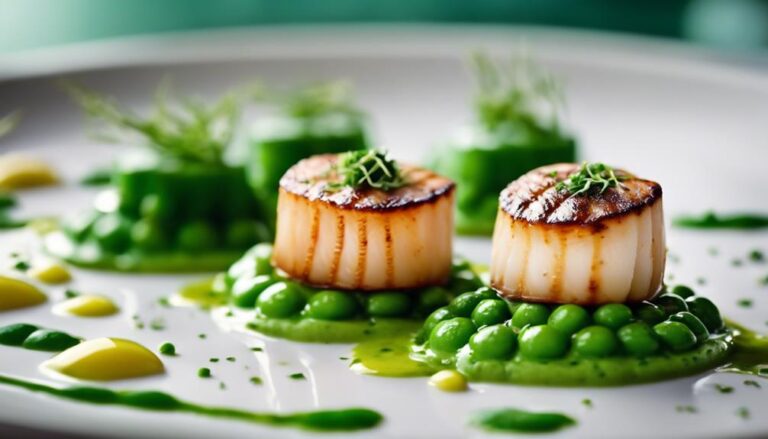Sous Vide Duck Breast With Red Wine Reduction
Achieve culinary perfection by pairing tender sous vide duck breast with a luscious red wine reduction. Begin by marinating the duck breast with herbs, citrus zest, and spices for depth of flavor. Sear the skin-side down in a hot pan until crispy, then flip for a golden finish. The Maillard reaction during searing enhances taste and texture. For best results, sear each side for 1-2 minutes, adjusting for desired crispiness. Elevate your dish with the harmonious balance of tender duck and rich reduction, creating a visual masterpiece to savor.
What You Will Learn Here
- Sous vide duck breast for precise cooking control.
- Create a rich red wine reduction sauce for depth.
- Sear duck breast for crispy skin and flavor.
- Pair dish with red wine to enhance flavors.
- Presentation tip: showcase beautifully seared duck with reduction.
Duck's Culinary Evolution
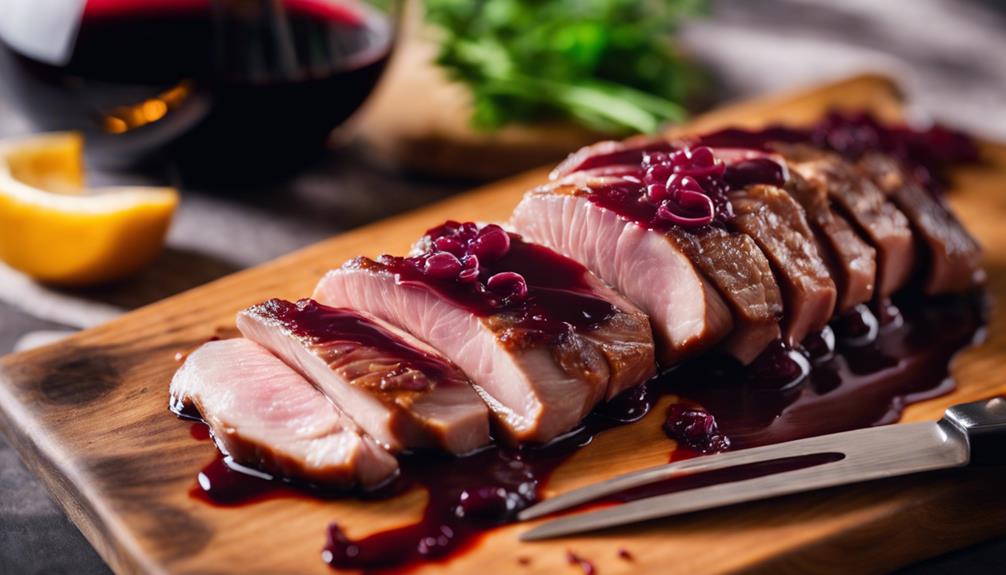
Duck's culinary journey spans centuries, from its historic importance to modern-day gastronomy.
You'll explore the evolution of duck dishes, from traditional recipes to innovative culinary creations.
Discover how chefs worldwide have embraced the versatility of duck, leading to a revolution in the culinary world.
Duck's Historic Significance
With a rich history dating back centuries, the culinary evolution of duck has been marked by its versatility and ability to inspire a wide range of dishes. Ducks have held symbolic and historical importance in various cultures, often representing prosperity, fidelity, and good luck.
In Chinese culture, ducks symbolize happiness and marital fidelity, often featuring prominently in traditional dishes like Peking duck, which dates back to the Imperial Era. Similarly, in French cuisine, ducks have been revered for their flavor and used in iconic dishes like Duck à l'Orange, showcasing the cultural significance of this bird.
Throughout history, ducks have been a staple in many traditional dishes worldwide, from the aromatic Duck Confit in France to the savory Teal Stew in England. Ducks have been celebrated for their rich, flavorful meat, making them a prized ingredient in culinary traditions across the globe. Understanding the historical importance of ducks in cuisine provides insight into how this bird has played a significant role in shaping culinary practices and traditions over time.
Modern Duck Cuisine
Exploring the evolution of duck cuisine in contemporary times reveals innovative culinary techniques and flavor pairings that elevate traditional dishes to new heights. The versatility of duck breast has been a focal point in modern culinary creations, with chefs experimenting with new approaches to showcase this prized ingredient. Modern techniques such as sous vide cooking have revolutionized the way duck breast is prepared, ensuring a perfectly cooked and tender result every time.
Chefs are now combining traditional methods with a contemporary twist, infusing flavors like citrus, honey, and exotic spices to enhance the natural richness of duck breast. This fusion of old and new creates exciting and dynamic dishes that tantalize the taste buds. Whether it's a crispy-skinned duck breast served with a tangy berry reduction or a tender sous vide duck breast drizzled with a savory red wine reduction, the modern culinary landscape offers a plethora of innovative ways to enjoy this classic ingredient.
Embrace the progression of duck cuisine and undertake a flavorful journey that celebrates the best of both tradition and innovation.
Culinary Innovation With Duck
Innovative culinary techniques have transformed the way duck is prepared, showcasing the evolution of this beloved ingredient in modern cuisine. Duck pairing ideas have extended beyond traditional offerings, now including innovative combinations like duck with fruit compotes or spicy chutneys. Culinary techniques such as sous vide have become popular for cooking duck, offering benefits like precise temperature control for perfect doneness and enhanced flavor profiles.
When exploring duck's culinary evolution, flavor profiles play an important role. Chefs are experimenting with diverse seasonings and marinades, creating unique taste experiences that elevate this rich protein. The sous vide method, in particular, has gained traction for duck preparation due to its ability to infuse flavors while maintaining the meat's natural juiciness.
The advantages of sous vide extend beyond flavor; this technique ensures tender and succulent duck meat, making it a favorite among both chefs and home cooks. By embracing new culinary techniques and flavor combinations, duck continues to captivate diners and inspire culinary innovation.
Duck's Flavorful Marinade
To enhance the flavor of your duck breast, consider marinating it in a mixture of herbs and spices for at least one hour before cooking. This flavorful marination not only infuses the meat with aromatic ingredients but also helps tenderize it for a more succulent outcome.
Here are some tips to elevate the taste of your duck through marination:
- Use Fresh Herbs: Opt for fresh herbs like rosemary, thyme, or parsley for a burst of freshness.
- Add Citrus Zest: Grate some citrus zest, such as orange or lemon, to bring a zingy brightness to the marinade.
- Include Spices: Incorporate spices like black pepper, coriander, or cumin to add depth and complexity to the flavor profile.
- Balanced Oil and Acid: Create a balanced marinade by combining oil for richness and acid like vinegar or wine for a subtle tang.
Duck Confit Recipe
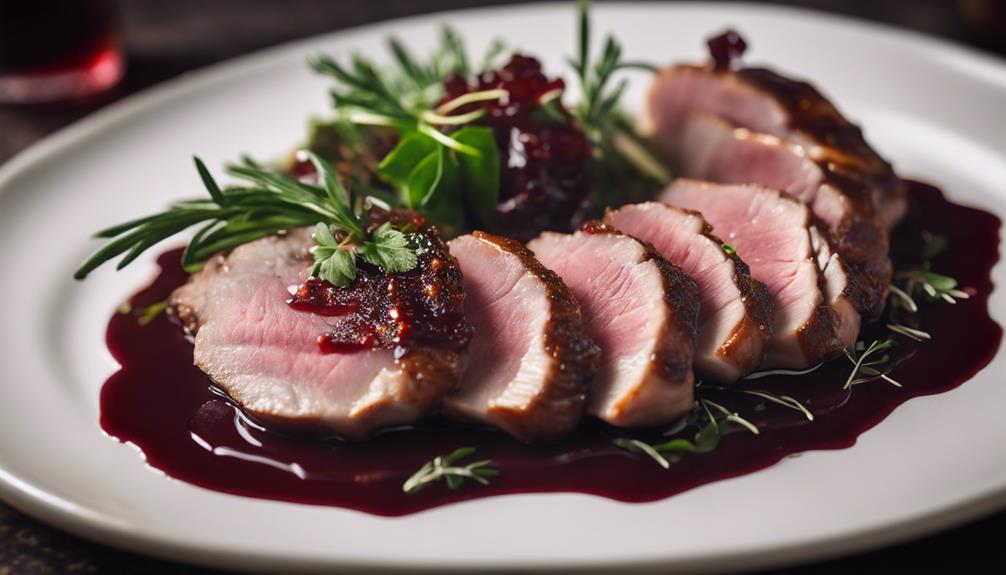
When making Duck Confit, you'll follow the POINTS outlined in the article.
Start with the Sous Vide Duck Breast Instructions to guarantee a tender result.
Then move on to crafting a savory Duck Leg Confit and preparing the flavorful Duck Rillette.
Sous Vide Duck Breast Instructions
For perfectly cooked duck breast in sous vide, follow these simple instructions for a delightful Duck Confit Recipe.
- Temperature Control: Set your sous vide water bath to 135°F (57°C) for medium-rare duck breast.
- Cooking Time: Let the duck breast cook in the sous vide for 2 hours to guarantee tenderness.
- Seasoning: Before vacuum-sealing the duck breast, season it generously with salt, pepper, and herbs for enhanced flavor.
- Searing: After sous vide cooking, pat the duck breast dry and sear it in a hot pan for a crispy skin finish.
Savory Duck Leg Confit
After mastering the Sous Vide Duck Breast instructions, you can now elevate your culinary skills with a delectable Savory Duck Leg Confit recipe. Duck legs are the star of this dish, cooked slowly in their fat to become tender and flavorful. Here are some key points to keep in mind as you prepare this savory delight:
- Slow Cooking: The duck legs are cooked slowly in their fat, allowing them to become tender and juicy.
- Flavor Infusion: The confit method helps infuse the meat with rich and intense flavors.
- Crispy Skin: By finishing the duck legs in a hot oven or pan, you can achieve a crispy and delicious skin.
- Versatile Dish: Duck leg confit can be served as a standalone main course or used to enhance other dishes like salads or sandwiches.
With these tips in mind, you'll be able to create a mouthwatering duck leg confit that's sure to impress your guests with its crispy exterior and tender, flavorful meat.
Duck Rillette Preparation
To prepare the Duck Rillette, start by shredding the tenderly cooked duck meat from the confit. Once you have the shredded duck meat ready, here are some tips to perfect your Duck Rillette:
- Duck fat uses, flavor: Utilize the rendered duck fat from the confit to enhance the richness and flavor of the rillette.
- Slow cooking techniques, benefits: Embrace slow cooking methods like confit for the duck meat to become tender, flavorful, and easy to shred.
- Seasoning and spices: Add a touch of salt, pepper, and other preferred spices to elevate the taste profile of your Duck Rillette.
- Textural elements: Consider adding in some finely chopped herbs or toasted nuts for added texture and depth to your rillette.
Searing Sous Vide Duck Breast
To achieve a perfect sear on your sous vide duck breast, it's crucial to grasp the significance of the Maillard reaction. This reaction is what generates that delightful golden crust on the outside of your duck breast.
Follow the recommended searing time to guarantee you lock in all the flavorful juices from the sous vide cooking process.
Perfect Sear Technique
To achieve a perfect sear on your sous vide duck breast, make sure that your pan is preheated to a high temperature. Searing methods play an essential role in flavor enhancement when finishing off your perfectly cooked duck breast. The key here is temperature control to guarantee the caramelization process occurs just right.
Once your pan is nice and hot, place your sous vide duck breast skin-side down. Let it sear undisturbed for a few minutes to develop that beautiful golden crust. This step not only adds texture but also intensifies the flavors locked in during the sous vide cooking.
When you notice the skin turning crispy and golden, it's time to flip the duck breast and sear the other side briefly. This quick sear on the flesh side will enhance the overall presentation and taste of your dish. With the right searing technique, you'll elevate your sous vide duck breast to a restaurant-quality meal that will surely impress your guests.
Maillard Reaction Importance
Achieving a deep, flavorful sear on your sous vide duck breast hinges on understanding the importance of the Maillard reaction. The Maillard reaction is an essential chemical process that occurs when proteins and sugars in the duck breast are exposed to high heat during searing. This reaction is responsible for the flavor development and the beautiful brown crust that forms on the surface of the meat. By searing your duck breast after sous vide cooking, you enhance its taste and texture, creating a more complex and satisfying dish.
Different cooking techniques can influence the Maillard reaction and the resulting flavor profiles. For example, using a hot skillet or grill to sear the duck breast quickly can promote a more intense Maillard reaction, leading to deeper flavors. Additionally, seasoning the duck breast before searing can contribute to the overall taste by adding complexity and enhancing the Maillard reaction.
Understanding the Maillard reaction and its role in flavor development is essential for achieving a perfectly seared sous vide duck breast with rich and savory taste profiles.
Searing Time Recommendations
Understanding the best searing time for your sous vide duck breast can greatly impact the final texture and flavor of your dish. When it comes to searing tips, temperature control is key. After the sous vide cooking process, ensuring your pan is hot enough for a good sear but not so hot that it burns the outer layer is essential for flavor retention.
The sear duration plays a significant role in achieving the perfect balance of a crispy exterior and a tender interior. Generally, for sous vide duck breast, a searing time of about 1-2 minutes per side is recommended. This timeframe allows for the Maillard reaction to occur, creating that desirable golden crust without overcooking the meat.
Keep an eye on the color and texture of the skin during searing. Adjust the time accordingly to achieve your preferred level of crispiness. By mastering the searing process with proper temperature control and timing, you can elevate your sous vide duck breast to a restaurant-quality dish right in your own kitchen.
Final Thoughts
Consider reflecting on the culinary journey you've just completed with this exquisite dish. The wine pairing and cooking techniques used in this sous vide duck breast with red wine reduction elevate the flavors to a whole new level. The tenderness of the duck achieved through sous vide cooking is paired perfectly with the rich and deep flavors of the red wine reduction. When considering flavor profiles, the combination of the savory duck with the slightly sweet and acidic red wine reduction creates a harmonious balance that delights the palate.
In terms of presentation tips, remember that a beautifully seared duck breast with a glossy red wine reduction drizzled over the top not only tastes exceptional but also looks stunning on a plate. The deep, dark color of the reduction against the golden-brown sear of the duck breast creates a visual masterpiece that's sure to impress your guests.
Frequently Asked Questions
Can Duck Breast Be Cooked Sous Vide Without a Vacuum Sealer?
Yes, you can cook duck breast sous vide without a vacuum sealer. Simply use the water displacement method. Place the duck breast in a bag, slowly submerge it in water to push out the air, then seal and cook.
What Is the Best Way to Store Leftover Red Wine Reduction Sauce?
To store leftover red wine reduction sauce, freeze it for longer shelf life. When ready to use, reheat gently to maintain flavors. Freezing options uphold quality, while reheating methods guarantee a tasty sauce for future dishes.
How Can I Prevent the Duck Breast From Becoming Tough?
To prevent duck breast from becoming tough, guarantee proper seasoning for flavor and tenderness. Control cooking time meticulously for best results. Avoid overcooking to maintain juiciness. Consistent temperature and timing are key for a perfectly cooked duck breast.
Can I Use a Different Type of Alcohol in the Red Wine Reduction?
Yes, you can use a different alcohol in the red wine reduction. Consider a white wine substitution for a lighter flavor or a port wine alternative for a richer taste. Experiment with different wines to find your favorite.
Should the Duck Breast Be Cooked Skin-Side Down When Searing?
When searing duck breast, always start skin-side down for crispy skin. Proper searing techniques enhance flavor profiles. Cooking temperatures affect texture and doneness. Pay attention to these details for a delicious dish every time.
Conclusion
To sum up, sous vide duck breast with red wine reduction offers a sophisticated and delicious culinary experience. By combining the traditional French technique of sous vide cooking with a rich red wine reduction, you can elevate the flavor of the duck to new heights.
Searing the duck breast after sous vide cooking adds a crispy texture that complements the tender meat perfectly. This recipe is sure to impress your guests and elevate your cooking skills to new levels.





